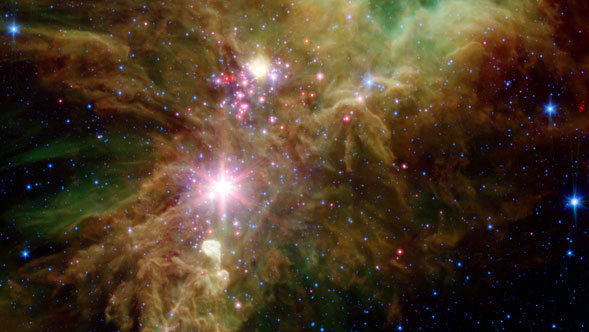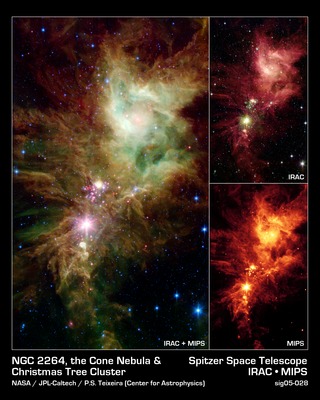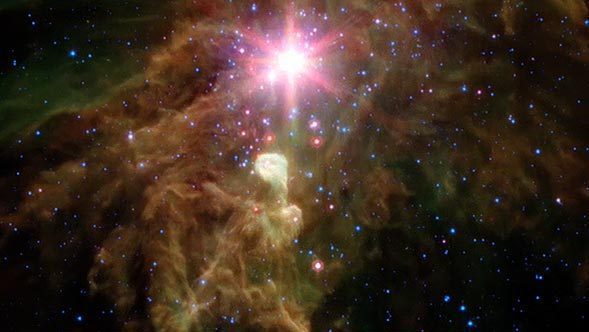
News Release • December 22nd, 2005 • feature05-28 •
Written by Linda Vu
Spitzer Science Center
The "Christmas Tree Cluster" has been seen sporting a shiny new decoration: an ornament made of newborn stars! But like a gift-wrapped package, these newborn stars are hiding behind thick branches of cosmic dust, only revealed in this spectacular new image from NASA's Spitzer Space Telescope. Astronomers say this stellar ornament represents the best laboratory to date for studying the physics of star formation.
The newly revealed infant stars appear as pink and red specks toward the center of the image. The stars appear to have formed in regularly spaced intervals along linear structures in a configuration that resembles the spokes of a wheel or the pattern of a snowflake. Hence, astronomers have nicknamed their new discovery the "Snowflake Cluster."
But like all snowflakes, this one won't last forever. Since the stars trace the straight line pattern of spokes of a wheel, scientists believe that these are very young protostars, or newborn stars. At a mere 100,000 years old, these infant structures have yet to "crawl" away from their location of birth. Over time, the natural drifting motions of each star will break this order, and the snowflake design will be no more.
According to the discovery's lead author Paula Teixeira, a PhD student working at the Harvard-Smithsonian Center for Astrophysics, star-forming clouds like this one are dynamic and evolving structures. She suspects that at a certain stage of their evolution, chaotic internal motions in the clouds cause strands of dusty filaments, or fragments, to form. As the filaments cool, gas and dust inside the strands clump and fragment further, eventually creating a line of evenly spaced protostars. The average distance separating the baby stars is determined by the temperature and the density of the filaments.
While most of the visible-light stars that give the Christmas Tree Cluster its name and triangular shape do not shine brightly in Spitzer's infrared eyes, all of the stars forming from this dusty cloud are considered part of the cluster.
Like a dusty cosmic finger pointing up to the newborn clusters, Spitzer also illuminates the optically dark and dense Cone Nebula, the tip of which can be seen towards the bottom left corner of the image. Meanwhile, the wisps of green indicate the presence of organic molecules mixed in with dust, which have been illuminated by nearby star formation.
The larger yellowish dots neighboring the baby red stars in the Snowflake Cluster are massive stellar infants forming from the same cloud. The blue dots sprinkled across the image represent older Milky Way stars at various distances along this line of sight.






